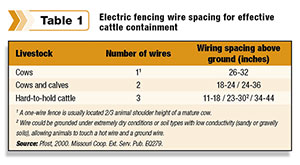Electric fence can be installed using polywire, polytape, or high-tensile wire. Use at least three strands of electric wire on perimeter fences and two strands on cross fences.
Solid corner posts and gate posts are very important. High-tensile fencing tends to place more pressure on the posts. Be sure H braces are sturdy.
High-tensile electric fences combine the strength of the high-tensile fence with an electrical component. The electrical component is used to provide an electrical shock to any animal that touches the wire.
One disadvantage of electric fences is that animals must be trained to stay away from the electric wire. With effective electric fencing, this training can be accomplished within a few days.
Depending on animal size, 12½ gauge high-tensile electric wires (180,000 to 20,000 psi strength) with a galvanized coating Class 3 are commonly used for permanent fences.
 Each high-tensile fence wire should have one in-line tightener for every ¼-mile of straight run to adjust tension.
Each high-tensile fence wire should have one in-line tightener for every ¼-mile of straight run to adjust tension.
Usually two “hot” wires are used to restrain livestock in lanes and paddocks, but the wire number and spacing depend on the type of livestock being constrained (Table 1).
A two-wire fence, with one wire charged and one grounded, may be needed for better livestock control in areas with shallow, rocky soils.
If the fixed area is larger than necessary to maintain animals for a specific number of days, subdivide it into paddocks with portable fences that can be moved to maintain grazing efficiency. Fixed fences at both ends will provide the necessary electrical charge to supply the portable fence.
Wire
Several types of wire are appropriate for portable electric fencing. The most commonly used materials for portable fencing are polywire and polytape.
They can be maintained by using a reel with step-in plastic posts. These fence wires are commonly fabricated of polyethylene and stainless steel, but other products containing fiberglass and aluminum or thin copper conductors are available.
Poly fences require no tools for setup, minimal bracing, and very light-duty line posts. One potential problem with poly fences is that internal resistance of the filaments used as conductors limits the distance at which they can be powered.
Polywire has the appearance of heavy cord or plastic polyethylene baler twine laced with several strands of stainless steel wire (three, six, or nine).
Polywire with six or nine strands is commonly used for longer runs without an excessive drop in voltage. Due to high resistance, the six-strand wire can effectively transmit charges for distances of up ½-mile; a distance of 2,000 feet is common. Nine-strand wire can transmit charges for ¾ to 1 mile. Polywire may last up to 10 years with proper use and maintenance.
Polytape is available in options similar to polywire, and it should be purchased on the basis of the number of filaments and quality of the plastic weave in the tape.
A good polytape contains at least six wire filaments. Polytape is more visible than polywire and tends to flutter in the wind, making it easier for animals to see and avoid it.
The life span for polytape is approximately 5 to 7 years due to wear by wind friction on post clips and insulators.
Reels
Reels are an essential part of dispensing and retrieving poly portable fences. Get one with a good locking system, adequate holding capacity, high-speed gearing, and a good manufacturer’s warranty.
The best locking system is a cog-and-lock lever system, which prevents the accidental loosening of fence. Reel capacities range from 300 to 1,320 feet of fencing.
Polywire capacities may range from 660 to 2,640 feet or even greater. If fences are to be relocated often, a geared reel is helpful.
Most reels work in a 1-to-1 retrieval ratio, but a geared reel can retrieve tape or polywire at a ratio of 3-to-1. A geared reel is typically more expensive; however, time savings will justify the purchase.
Most reels are durable, but they are plastic. Therefore, a good warranty is advisable. Most warranties range from zero to five years for replacing plastic parts. Check with the dealer or manufacturer about terms and conditions.
Posts
Common wood posts and steel posts are used with insulators for permanent electric fences. Plastic and fiberglass posts are the most common line posts used with electric fences.
Fiberglass posts come in different diameter sizes, including 3⁄8”, 1⁄2”, 5⁄8” and larger, and are used without insulators.
Drought or freezing conditions may compact the ground, which can limit the efficiency of posts. Certain types of imported posts, such as well-cured hedge (osage orange, red cedar, and black locust) can be used without insulators if high soil moisture levels do not reduce guard voltage.
Different models of step-in posts are also available; choose one with a step large enough to accommodate a person’s foot completely so the post can be driven or pushed into the ground easily.
The post should be rigid enough to withstand windstorms but flexible enough to bend under excessive pressure. Be sure posts have the appropriate spike diameter. For high-tensile fences, use corner wood posts that are 8 feet tall, 5 to 6 inches across, and have adequate H-bracing.
Insulators
High-quality insulators are important in corners and ends of permanent electric fences. UV-stabilized, high-density polyethylene or polypropylene insulators are recommended for use on wood or steel posts of permanent electric fences. Porcelain insulators can work if they are high quality.
However, they are less desirable because they can crack under high strain, allowing in moisture that could create an electric short.
With double-hole insulators, make sure the two wires cross one another to load the insulator under compression. Loading the double-hole insulator under tension can split it in half.
Energizers
Using an adequate energizer, or charger, for electric fencing is very important. If electricity is not available, battery or solar energizers can be used.
The first step is to choose a low impedance, high-voltage charger. There are several excellent ones on the market that include solar, battery, or household hook-up.
It is important to have a charger that can deliver an adequate electrical shock under unfavorable conditions such as dry ground or excess vegetation touching the wire. Plants and poor insulators can bleed off electricity from an electric fence.
Proper grounding of an electric fencing system is a must. Drive at least three 6-foot ground rods into the ground at 10-foot intervals. Alternating hot and ground wires on the fence structure can be effective in cattle restraint. Start with the top wire electrified.
Some chargers are rated in miles of fence or in acres. The longer the fence, the more powerful the energizer must be to send an effective charge throughout its length.
Make sure the charger has indicators showing correct operation, input voltage, high/low switch or separate output terminals for dry or normal conditions, and a light that indicates when the fence is charged. Battery-powered units should also have a half-power option.
Select a charger approved by Underwriters Laboratories or the U.S. Bureau of Standards, and do not use homemade chargers. Chargers are usually powered by a 6- or 12-volt AC battery, by solar panels, or by main lines using 120 or 240 volt AC power
Main lines usually deliver a good shock under the favorable conditions described previously. Main-type chargers should be placed in dry areas with easy access for inspection but protected from access by animals and small children.
When selecting a solar panel, make sure it can provide at least 10 watts of solar panels per joule of output and that the panel is oriented to receive the maximum amount of sunlight.
It is important to select a charger with output characteristics that match the length of fence to be energized.
The charger should also meet the expected operating conditions, such as moisture levels in the air and soil, degree of contact with vegetation, wire size, total length of the wire, and length of the hair or wool on animals being fenced.
The guard voltage, or voltage present at any point on the fence where an animal may contact it, can range from 2,000 to 4,000 volts. Usually 2,000 volts is sufficient for cattle under normal conditions, and 4,000 volts can be used under extremely dry conditions or for well-insulated animals such as sheep.
Also check the ground line voltage with a voltmeter to ensure proper charge flow. It is wise to buy a charger with excess capacity to allow for future expansion.
Another option is to buy one or more chargers and divide the fence into perimeters, but never connect two chargers to one perimeter.
Grounding
The size of the energizer, the grounding material itself, soil type, and soil moisture can all play a role in designing an effective grounding system. Inadequate grounding is one of the most common failures in properly constructed, insulated, and electrified fencing systems.
Poor grounding causes weak shocks. In an electric fencing system, the electricity must complete a full circle back to the charger through the ground.
It is important to install several ground rods – at least three that are 6 to 8 feet long and attached with good ground clamps. Copper or galvanized rods are the most commonly used metals.
Use the same type of metal throughout the system. Each metal has a different ability to conduct electricity and a different rate of expansion or contraction in response to power surges and temperature changes.
In addition, when a steel wire is hooked to a copper wire, the metal corrodes, causing poor contact and weakening shock power.
The corrosion limits the amount of electricity able to flow through the system, and the electricity that does flow seeks an alternate route back to the energizer, creating a stray voltage risk.
Gates
Gates may be purchased or custom designed. Several manufacturers sell plans for gates, people passages, and cattle guards.
Electrical charge at gates can be passed through underground wiring or overhead wiring high enough to clear animals and equipment. If placing the wire underground, pass the wire through plastic pipe to decrease the possibility of creating a short circuit.
Gate placement is especially important under rotational grazing, because animals will be moved frequently, but it is important in all grazing systems so animals can be moved to handling facilities for health treatments or other management practices as needed. A gate should be in a corner of the paddock to allow easy animal movement down the alleyway.
Different tasks can be achieved with all the available livestock fencing technologies. Electric fencing makes subdivision relatively fast and inexpensive.
However, the effectiveness of these fences relies on proper construction and the ability to carry the charge. The success of electric fencing can also be dependent on the cattle.
Well-behaved livestock that are regularly handled and familiar with electric fencing will treat a single “hot” wire with at least as much respect as they would a barbed wire fence.
Livestock, especially calves, can be quickly and easily trained to electric fences with a temporary wire in the pasture. Once livestock are shocked a few times, they should respect electric fences.
Summary
In addition to keeping livestock out of the neighboring pastures and off the major highways, fencing is a key component of good grazing management.
Fencing allows control over both the movement of livestock and the productivity, quality, and utilization of forage crops.
Low-cost, semipermanent and temporary electric fencing systems make controlling and efficiently using pasture resources easier than ever. Well-designed fencing, water, and shade systems can make a big difference in animal comfort and productivity as well as labor efficiency. FG
—Excerpts from Mississippi State University Extension website










